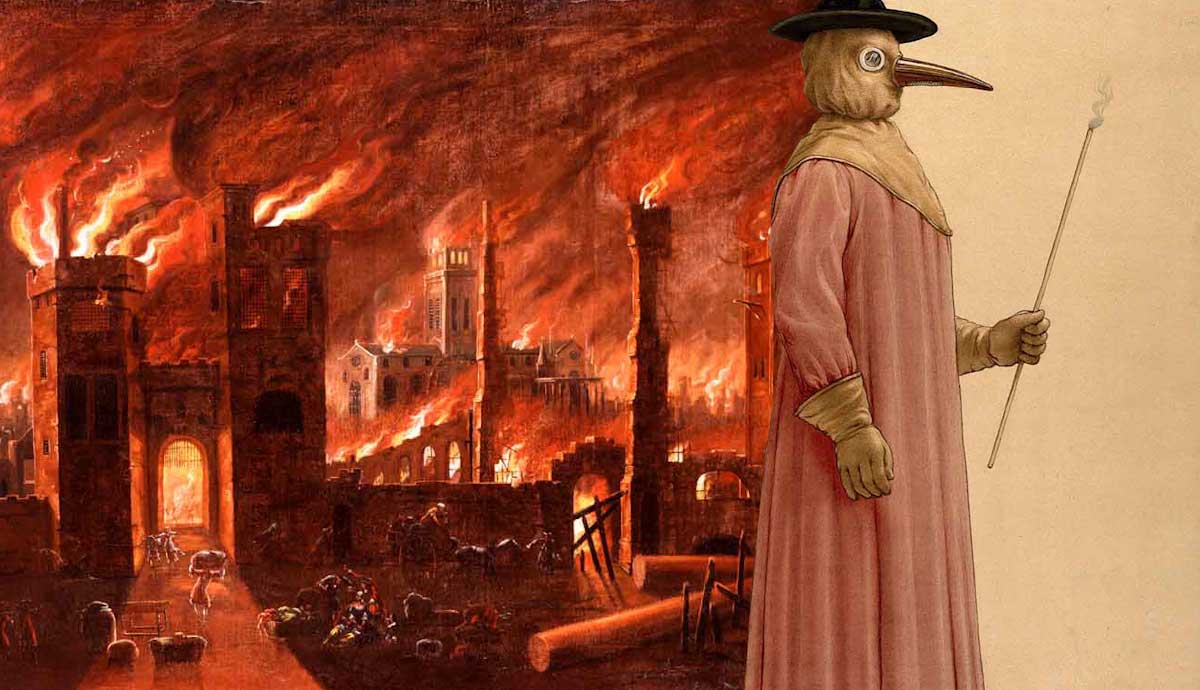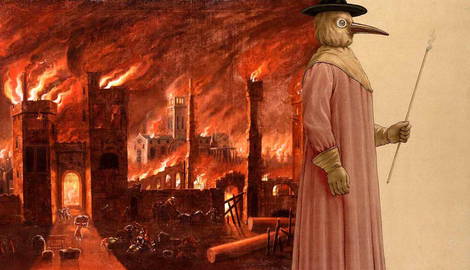
Between 1665 and 1666, London saw one of its worst outbreaks of the plague since 1348. The government eventually introduced public health measures that restricted people’s movement in a way that would not be seen in London again until the COVID-19 outbreak in 2020. Now, just a couple of years after the outbreak of COVID, and while much of the world is still feeling its lasting effects, it is especially interesting to consider how people in the past dealt with very similar public health disasters.
Death Travels up the River: The Great Plague Arrives in London

London was well acquainted with the plague by the seventeenth century, as there had been several outbreaks in the city since 1348. Despite this, the Great Plague of London in 1665-1666 was perhaps the worst. Estimates report that about 15% of London’s population was lost, and while official records report 68,596 deaths, it is more accurate to assume that the number was probably over 100,000.
The disease first arrived in 1665 in St-Giles-in-the-Fields, a parish just outside the city walls. It then spread into the heart of the city, and by September, it was reported that 7,165 people in London had died in just one week. Transported through the overcrowded city by rats infected with the bacterium Yersinia pestis to the seventeenth-century inhabitants of London, the disease appeared to not discriminate against the victims it chose.
In the end, the only thing that stopped the plague in 1666 was the Great Fire of London, which ripped through the city and destroyed a lot of the infrastructure as well as the infected rats and fleas. Prior to this, the local government had attempted to put in place some public health measures in order to prevent the spread of the disease.
Seventeenth-Century Lockdown

One of the two main ways the government attempted to control the spread of the disease was by “shutting up” houses. This early concept of quarantine was born in 14th century Venice, where ships were held at ports for 40 days after their arrival to ensure that they did not bring disease into the city. The word quarantine comes from the Italian quaranta giorni, which translates to “forty days.”
The concept has evolved over time, and it is now defined in the Cambridge dictionary as “a specific period of time in which a person or animal that has a disease, or may have one, must stay or be kept away from others in order to prevent the spread of the disease.”
The concept was loosely employed in seventeenth-century England. In 1630, the Privy Council in London ordered that any houses infected with plague be “shut up.” The process began when someone passed away. Government-appointed “searchers” would be sent out in order to ascertain how the individual had died. If it were understood to be the plague, the house would be “shut up.”
Understandably, the thought of being locked in their own homes and left either to die of the plague or to catch it off a fellow family member did not appeal to most. It was therefore common for individuals who were aware they had the plague before the searchers were sent to disguise their malady. Those who were wealthy enough sometimes even resorted to bribery to avoid being locked in their house to eventually die. Because these searchers were often older, poorer women, they were extremely likely to take these bribes.

In order to ensure their rules were adhered to, guards were placed outside the doors of such houses to ensure that no one left. The local constable padlocked the doors to the homes; they were then marked with a red cross with the words “Lord had mercy upon us” written alongside it. This was done to prevent people from entering the home and warn others that those inside were infected.
The law stated that this quarantine should last 20 days; however, this period was extended if one of the individuals inside passed away. During this period, the houses marked with these crosses were looked upon with immense fear. There were few offers of help from the outside, and Samuel Pepys, a London resident at the time, reports that “…a gentleman walking by called to us to tell us that the house was shut up of the sickness. So we with great affright turned back, being holden to the gentlemen; and went away.”
There were also reports of escapes. Naturally, healthy people did not like the idea of being locked within an infected house for 20 days, where they would more than likely catch the disease themselves. Eventually, these orders developed into sending infected people to Pest Houses.
More Extreme Measures: The Pest Houses

Alongside at-home quarantine, the Privy Council employed another method to control the plague’s spread: Pest Houses. The Earl of Craven stated that shutting up families within their homes was inhumane and ineffective. He argued for the use of Pest Houses, which were effectively isolation hospitals where sick people, or those who had been in contact with the disease, could be taken until they recovered.
If searchers who were sent out to look for people who had the disease but had not identified themselves discovered someone with the plague, they could send the suffering individual to the local Pest House rather than back to their own house to isolate.
It was up to the families whether they would move with an infected relative to the Pest House or stay at their home and quarantine. If the entire family went to the Pest House, then the infected home would be quarantined. The door would be marked with a red cross; however, no inscription would be made in order to show that the house was empty. Again, guards would be stationed outside the house to ensure that no one entered them or looted them.
Records that survive from the period and depict the construction of Pest Houses show that they were made up of two buildings: one for the infected and one for the healthy but exposed. They were both designed in the same fashion: tall stone walls and big windows. The big windows were to ensure airflow and to release any miasmas (bad smells) from the buildings as it was believed they were what caused disease.
These establishments were ruled over by a master or mistress, who, in turn, employed nurses and watchmen. The gates around the property were locked to prevent people from escaping.
Masks

The use of masks was also employed during the outbreak of the plague, but not in the way we may assume. Normal individuals were not wearing masks; doctors were. The plague mask has become a distinct visual of early modern medicine, but why was it worn?
Christian J. Mussap has accredited the introduction of this mask and the entire outfit to the French doctor Charles de Lorme. De Lorme described the beaked mask as:
“… half a foot long, shaped like a beak, filled with perfume with only two holes, one on each side near the nostrils, but that can suffice to breathe and carry along with the air one breathes the impression of the [herbs] enclosed further along in the beak.”
The reason doctors adorned this mask filled with herbs was because of the belief in miasmas, or bad smells. The dominant medical theory at the time stated that disease was spread through miasmas. Thus, by filling their masks with nice-smelling herbs, doctors ensured the disease could not be passed on to them while working with patients.
The most common substance used in the mask was theriac, a mixture of over 55 herbs and other substances like honey or cinnamon. Unfortunately for those who wore these masks, these herbs were ineffective against plague since it was actually caused by bacteria.
Another Disaster Brings the End

Fortunately (or unfortunately) for the inhabitants of seventeenth-century London, another one of the city’s worst disasters took place in 1666. The Great Fire of London ripped through a large section of the city, thus killing off a lot of the infection. The buildings in London were made of timber with thatched rooves and built extremely close together, meaning they caught fire at an alarming rate.
The situation was only made worse by the fact that London had no organized fire brigade at this time. Attempts were made to control the fire; however, little could be done to prevent the blaze from spreading.
Arguments have been made for and against the idea that the fire halted the spread of the plague. Some, like Meriel Jeater, have argued that the plague was actually declining prior to the outbreak of the fire. Jeater contends that the fire couldn’t possibly have ended the plague because the fire only spread through about a quarter of London. Furthermore, the areas most affected by the plague, Southwark, Clerkenwell, and Whitechapel, were not touched by the fire.

There are various ways the plague could have decreased on its own. For example, because there would be a rat epidemic prior to a human epidemic, it could have reached a point where there were simply no rats left to act as reservoirs for the disease. This, combined with the fact that much of the human population had either died or fled and the fact that the colder months would have made it harder for fleas to survive, meant that there is a possibility the disease struggled to keep infecting people at the rate it once had.
Whatever caused the decline of the plague after 1666, there is still no doubt that while it terrorized London with full force, it remained a great source of fear and unease to many. Not only was the disease associated with fears of death and suffering, but also of being separated from one’s family members.










